Japan
Note this page is still under construction. |
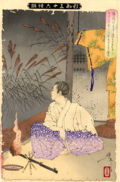
Japan, Japanese, Nippon or Nihon 日本 is an island nation located in eastern China , from Korea and Russia , originally inhabited by the Aïnous アイヌ who no longer represent only about 1 percent of the total population.
Japanese civilization was shared between the influence of surrounding countries (China, Korea, India ) and even distant (Europe, USA ) and the desire to preserve its peculiarities.
From 1641 , after having expelled the missionaries Christians and other foreigners, and severely limited external trade, Japan remained closed to Western penetration for over two centuries. However, it was forced to open up from 1853 under the explicit threat of the US war fleet.
The wakashudō, , also called nanshoku, is a social, emotional and sexual bond formed between a male adult and a young boy . Existing since at least the eighth century and lively until the nineteenth, it is the institution pederastic most durable attested in the history of mankind.
Notes on Japanese mentality
The preeminent social order in Japanese Confucianism is: first come the samurai (warriors), then the farmers, artisans, and finally the traders.
However, the social structure by age is given greater weight than status.
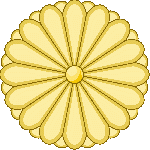
There are no Japanese taboo regarding anal sex (excrement is not seen as an impure waste, but as a fertilizer). Anal intercourse was therefore not stigmatized other than possible pain it might cause and the passive role was neither demeaning nor feminizing.
We note in this regard that the chrysanthemum flower is both the symbol of the Emperor, and the anus in nanshoku.
Nanshoku and wakashudō
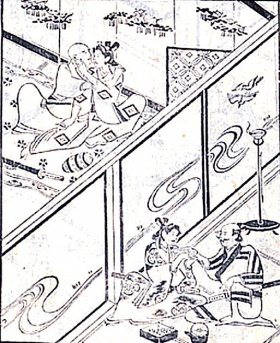
A samurai and his young disciple (shudo tale, 1661)
In the pre-modern period, Japanese pederasty was generally designated by two rather different terms:
- nanshoku男色(or danshoku) means "manly lust" or "lust between males". It refers to pederastic or homosexual sex.
- wakashud 若衆道 consists of dō道character that reminds the Chinese tao, the path along which we progress; and the word Wakashū若衆, "young person" or more accurately "boy": it is literally the "way of the boys."
It also meets the abbreviated forms shudo衆道若道and nyakudō.
- Also included in the same direction Bido美道, "beautiful way".
To sum up, nanshoku evokes pleasure, passion, virility; while wakashudō and our refers to a pursuit of wisdom focuses on young boys.
The Wakashū (boy) to be involved in the wakashudō corresponded to a defined age group, but with very fluctuating boundaries as appropriate. He could have, in the extreme, from five to twenty-five. It is often considered the best age from fourteen to eighteen years. However puberty was probably later today; Furthermore, the low hairiness of the Japanese gives them a more sustainable youthful appearance as European adolescents.
Religions
It is found mainly in Japan cult Shinto and Buddhist , often mixed with a view Confucian . Christians now account for 2% of the population, the Islam is almost nonexistent.
There is no sexual taboo in Shinto, which considers it an absolute pleasure as well. Similarly to Confucianism.
In Buddhism, each monk vowed to abandon all sexual thoughts towards women . While the abstinence total is preferable, the sexuality with males is seen as a last resort, to calm the inevitable reproductive ardor.
The Taoism , which strongly influenced the Japanese Zen Buddhism cares about balance. He says the reports heterosexual cause in humans a catastrophic loss of energy, and therefore should be moderate. This risk does not exist in the case of homosexual sex.
None of these religions considers pederasty and homosexuality as practices against nature .
Shinto deities
During Tokugawa shogunate (from the seventeenth to the nineteenth century), many gods Shinto were considered the guardian deities of nanshoku, especially Hachiman八幡神, Myoshin, Shinmei and Tenjin天神. It also evoked Hotei布袋(called Budai in China), the laughing Buddha, often surrounded by beautiful boys who revere.
The writer Ihara Saikaku says jokingly that since there are no women in the first three generations of divine genealogy described in Nihon shoki日本書紀("Chronicles of Japan"), the gods have always had sex - and considers this as the true origin of nanshoku. [1]
Buddhist deities
Buddhism spread to Japan in thirteen major schools, was imported from China from the fifth century . He took a particular importance to the Nara period (VIII century).
Monju文殊or Monjushiri文殊師利is the Japanese name Mañjuśrī , the great bodhisattva [[[2]]] of wisdom. However, according to later traditions, it would be the inventor of nanshoku. [[[3]]] It should be noted that one of his names in Sanskrit is Mañjuśrī Kumārabhūta ("Juvenile"), and that China may be called as Rǔtóng Wenshu 孺 童 文殊 "Wenshu young children" or Fǎwángzǐ 法 王子 "Son of the Buddha."
Spiritual Masters
Despite the hostility of Buddhism, in some countries at least, against homosexual practices, the origins of male homosexuality is associated in the minds of Japanese Buddhist institution.
The monk Kūkai空海, also known as Kobo Daishi-弘法大師( 774 - 835 ), is the founder of the branch真言Shingon Buddhist Tantric , as well as an important monastic community. He is said to have introduced pederasty in Japan at his return from China in 806 ; but some consider that this reputation was induced or exacerbated by the missionaries Francis Xavier. The name of Mont Kōya高 野山, which remains to this day the monastery founded by Kūkai was commonly used until the end of the pre-modern era, to designate the kind pederastic relationships.
History
The beginnings of nanshoku
No source mentions the possible existence of pederastic practices in Japan of antiquity .
Several descriptions of homosexual acts exist in ancient literary works, but most are too subtle to be easily identified because the displays of affection between same sex were common. The primary sources some date back to the Heian period, around the eleventh century .
In The Tale of Genji 源氏物語 wrote at that time, men are often attracted to the beauty of young boys. One scene shows for example the hero repulsed by a woman who will sleep with the little brother of the latter:
| “ | Well, at least you will not abandon me." Genji pulled the boy to sleep next to him. The boy was delighted,both Genji had juvenile charms. Genji for his part, said, found the boy more attractive than his chilly sister. |
” |
The Tale of Genji is certainly a novel, but some stories from the same era and until the first half of the fourteenth century , also contain descriptions of pederasty acts. Some of them even involve emperors with "beautiful boys for sexual purposes".[2] But they gave rise to no pederastic tradition, unlike what had happened in China in the Antiquity.
Time monasteries
Monastic communities grow from the ninth century . At the end of the sixteenth century , Japan has about ninety miles. Some are home to a thousand men and boys, and the largest up to three miles. Monks can keep with them for novices called chigo稚児, children or teenagers from large families, just come to learn about the liturgy or prepare a monastic career.
The sexual relationship between a monk and chigo are common. They include anal sex . Each partner has a name and takes a specific role: the elder (nenja念者" lover , admirer, "nenyū, anibun, anikibun, Kyukyu) and the youngest (Wakashū若衆"young person", nyake, otōtobun) contract a link fraternal (Kyodai keiyaku or Kyodai chigiri) and swear loyalty to each other.
In 1419 and 1436 , a ban will be made to the monks, not to have sexual relations with their novices, but to disguise them girls. However, it is well expected that these boys they became men, and taste for disguise purely aesthetic and erotic , was not intended for the feminize their behavior.
European observations
The first Europeans to visit Japanese soil were struck by the frequency and type of advertising pederastic relations. So the Jesuit Portuguese Alessandro Valignani he observed in 1591 :
|
" |
Young boys and their partners, not considering the matter as serious, do not hide. In fact, they see honor and speak openly. Not only the doctrine of the monks do not take for a sore but they themselves practice this custom, for holding the absolutely natural and even virtuous. |
» |
The time of the samurai
It is the eighth century, at the end of the Nara period, [[[5]]] as the first professional warriors appeared, young riders archers from affluent backgrounds. They formed a militia of 3964 men, who give way to the tenth century to the samurai caste.
Many samurai First geoscience characterized novices in a monastery. Monastic morals therefore used as models for love men who were soon underway at these warriors. The feudal structure of society contributed well to structure these relationships.
As between a monk and a novice, the relationship between two samurai begins with oaths fraternal possibly writings, which then constitute a real contract (in this case, the relationship is monogamous). Many of these contractual oaths have been preserved, including joining Takeda Shingen (best known in the West as the central protagonist of Kagemusha Kurosawa film) and her lover Dansuke Kasuga, then aged twenty-two and six years respectively.
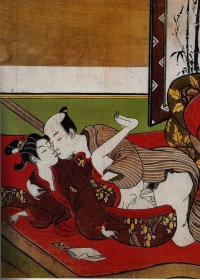
Détail d’un shunga montrant un homme et un garçon, vers 1750
(Londres, Victoria and Albert Museum)
Unlike pederasty Greek , the initiative to start such a relationship back to the boy. But as the apprentice samurai was often very young in the early wakashudō - between ten and thirteen years - we think it is usually the parent who sought him a master .
The young samurai serves his elder during military campaigns. In peacetime, it often acts as a page at the effeminate look.
Wakashudō principles are part of a rich literary tradition; we find such statements in books like Hagakure or various manuals for samurai. Through its educational, military and aristocratic, the wakashudō strongly resembles the Greek pederasty.
This practice was held in high regard and saw encouraged within the samurai group. It is considered beneficial for the boy, in that it taught him virtue, honesty and sense of beauty. Love for women, in contrast, was accused feminize men.
|
" |
The nanshoku is the leisure Samurai: how could it be detrimental to good government? [[[6]]] |
» |
Time theaters
From the seventeenth century, as the samurai were inspired formerly of nanshoku monks, bourgeois merchant class will begin to imitate the boyish love of the samurai, but adapting them to their own principles.
The values of love and honor that prevailed previously are then gradually replaced by those of pleasure and money. The education gives way to prostitution , the manhood to effeminacy. In return, the moral degradation will eventually contaminate Samurai monastic classes.
Prostitution
During the Edo period ( 1600 - 1868 ) the onnagata, kabuki actors interpreting adult female roles also often worked as prostitutes.
The KAGEMA were male prostitutes working in brothels specialized kagemajaya陰間茶屋called "tea house of KAGEMA". Existed in the nineteenth century twenty-four red light districts boys in Tokyo .
Both KAGEMA onnagata that were popular fine people, often followers of nanshoku. A male prostitute cost much more than a woman was paid a luxury prostitute 5 monme the pass, while a boy was worth between 43 and 129 monme. [[[7]]]
Modern Japan
With the beginning of the Meiji Restoration and the growing influence of Western culture, and wakashudō all homoerotic practices are beginning to be subject to criminal sanctions and rapid decline in the late nineteenth century.
Man-boy sex
The minimum legal age for sexual relations between men and boys is set differently in different prefectures (or departments), which number forty seven. However, the legislation "central" passed by the Diet primacy over local laws. But if the trial courts apply the laws local, the appellate courts must follow the central law.
This system a bit complex, but respectful of local
features, results in a man can be condemned in some prefectures,
for having sex with a boy of fourteen. But if he uses - which then
is in their interest - it will be judged according to the central
law which permits adult-minor relationships from thirteen: it will
be eventually acquitted.
Erotic materials
Real and virtual pornography
Production, distribution and possession of documents child pornography are prohibited in Japan, they show real miners.
Since June 2014
, the mere possession of such documents is a crime punishable with
imprisonment (up to a year) and a fine of up to one million yen.
However, the persons concerned have a period of one year to come
into compliance with the new law.
The imaginary representations (drawings, etc.) are
allowed.
Other equipment
Erotic materials proposed in Japan can be quite surprising for a Western mind.
For example, the
firm offers Tama KanojoToys on the site for 17 euros or 23 dollars,
a "bottle boy anus smell" that can feel "a otoko
no ko, a women boy who looks almost
exactly like a girl except for that thing between his legs and the
unique smell .... " [[[8]]]
Literature
- Several chigo monogatari anonymous tell the monks of love with young novices.
- Ihara Saikaku [[[9]]]井原西鶴or Saikaku ( 1642 - 1693 ): nanshoku Okagami男色大鏡(The Great Mirror of Male Love), 1689 .
Fine Arts
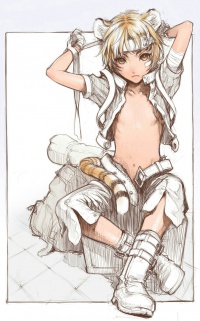
Painting
Shunga
Shunga|春画 is a Japanese term for erotic art. Most shunga are a type of ukiyo-e, usually executed in woodblock print format. While rare, there are extant erotic painted handscrolls which predate the Ukiyo-e movement.[3] Translated literally, the Japanese word shunga means picture of spring; "spring" is a common euphemism for sex.
Manga
Manga 漫画 are comics created in Japan, or by Japanese creators in the Japanese language, conforming to a style developed in Japan in the late 19th century.[4] They have a long and complex pre-history in earlier Japanese art. [5]
Shotacon
Shotacon ショタコン is a Japanese slang portmanteau of the phrase Shōtarō complex (正太郎コンプレックス shōtarō konpurekkusu?) and describes an attraction to young boys. It refers to a genre of manga and anime wherein pre-pubescent or pubescent male characters are depicted in a suggestive or erotic manner, whether in the obvious role of object of attraction, or the less apparent role of "subject" (the character the reader is designed to associate with), as in where the young male character is paired with a male, usually in a homoerotic manner. The term shota is an abbreviation.
Cinema
- Shima Koji島耕二( 1901 - 1,986 ): Maboroshi no uma幻の馬(Horse and the child), 1955 .
- Gosho Heinosuke五所平之助( 1,902 - in 1981 ): Jinsei no onimotsu人生のお荷物(The burden of life), 1935 .
- Ozu Yasujirō小津安二郎( 1903 - 1 963 ): Otona no miru ehon - Umarete wa mita keredo大人の見る絵本生れてはみたけれど(I was born, but ... = Yet we are born = Kids of Tokyo), 1932 ; Deligokoro出来ごころ(capricious Heart), 1933 ; Tokyo no yado東京の宿(An Inn in Tokyo), 1935; Nagaya shinshiroku長屋紳士録(Story of an owner), 1947 ; Ohayoお早よう(Hello), 1959 .
- Shimizu Hiroshi清水宏(1 903 - 1966 ): Kaze no naka no kodomo風の中の子供(Children in the wind), 1937 ; Hachi no su no Kodomotachi蜂の巣の子供たち(Children of the honeycomb), 1948 .
- Hiroshi Inagaki稲垣浩( 1905 - 1.98 thousand ): Muhomatsu no Issho無法松の一生(The rickshaw), 1958 .
- Kinoshita Keisuke木下惠介( 1912 - one thousand nine hundred ninety-eight ): Niju-shi no hitomi二十四の瞳(Twenty-Four Eyes), 1954 .
- Shindō Kaneto (1912 - 2012 ): Genbaku no ko原爆の子(Children of Hiroshima), 1952 ; Hadaka no shima裸の島(Naked Island), 1961 .
- Nagisa Ōshima大島渚(one thousand nine hundred thirty-two - 2 013 ): Shōnen少年(The Boy), 1969 .
- Terayama Shuji寺山修司(1935 - 1983 ): Tomato Kecchappu koteiトマトケチャップ皇帝(Emperor Tomato-Ketchup) in 1971 in censored version, 1996 uncut; Den'en or Shisu田園に死す(Pastoral Hide and Seek) 1974 .
- Gotō Toshio後藤俊夫(born 1938 ) Matagiマタギ(Matagi old bear hunter), 1982 .
- Oguri Kōhei小栗康平(born in 1945 ): Doro no kawa (River mud), 1981.
- Kore-eda Hirokazu (born in 1962 ): Dare mo shiranai誰も知らない(Nobody Knows), 2004 ; Kiseki奇跡(= I wish our secret wishes), 2011 .
Erotic videos
In the 1990s were produced in Japan VHS videos juvenile eroticism professional quality. They usually acted out boys teenagers and pre-teens in a very neat and pretty slow style. At the end of each video were often given the names of the young actors, their ages and measurements.
Personalities and foreign works related to Japan
- Karl Kliest , born in Beijing in 1931 , died in New South Wales in 1976 , including the Japanese childhood is told in Paedomorphs I: the story of a young boy in pre-war Japan . [[[10]]]
Citations
They were wonderful stories of small pages loving old nobility and threatening to do harakiri if the noble old did not accept their advances; priests selling the relics of their temples to maintain acolytes; samurai who were begging to track, from province to province, another cute samurai.
- Roger Peyrefitte, The exile of Capri , Paris, Le Livre de Poche (Pocket book), 1974 Part Three, chap. III, p. 260-261 ( see reference sheet )
See also
Bibliography
- Downsbrough Nigel Paedomorphs. I: the story of a young boy in pre-war Japan. - Taipei: Kiryudo Publishing Co., 1978.
- "Nanshoku: male-male eroticism in Japan", in Koinos Magazine , nr 40 (April 2003) and nr 41 (January 2004).
- Pflugfelder, Gregory M. Cartographies of desire: male-male sexuality in Japanese Discourse, 1600-1950. - Berkerley: University of California Press, 2000.
- [Ihara Saikaku] Saïkakou Ebara. Tales of love samurai / trans. Ken Sato; Patrick Raynaud drawings. - Jacques Damase, 1981. 7 stories of samurai and 4 stories of actors, from the glorious stories of pederasty, Stories of the samurai spirit Stories duties of samurai and letters in Stories.
- Ihara Saikaku. Amours samurai / trans. Japanese and presented by Gérard Siary; with the collab. Mieko Nakajima-Siary. - Arles: Philippe Picquier 1999 (Aubenas Print Lienhart.). - 250 p. : Ill., Cov. Fig. col. ; 21 cm. - (The great mirror of male love: love custom boy in our country; 1) (Pavilion curious body ISSN 1274-9508). Trad. of the 1st part: nanshoku Okagami. - Includes bibliographical references. p. 59-65. - ISBN 2-87730-451-5 (br.)
- Ihara Saikaku. Amours actors / trans. Japanese and presented by Gérard Siary; with the collab. Mieko Nakajima-Siary. - Arles: Philippe Picquier, 2000 (Gemenos Print Robert.). - 217 p. : Map, cov. Fig. col. ; 21 cm. - (The great mirror of male love: love custom boy in our country, 2) (Pavilion curious body ISSN 1274-9508). Trad. the 2nd part: nanshoku Okagami. - Glossary. - ISBN 2-87730-469-8 (br.)
- Tsuneo Watanabe, Jun'ichi Iwata The way of youths. History and stories of homosexuality in Japan. - Ed. Trismegistus, 1987. - (Eastern Sexuality) ( ISBN 2-86509-024-8 )
Related articles
Media-BoyWiki
has media related to
Japan
- Bishōnen
- Chigo
- Chigo Monogatari
- Japanese pederastic couples
- Ihara Saikaku
- Kūkai (Kobo Daishi-)
- Nanshoku Okagami (Ihara Saikaku) (The Great Mirror of Male Love)
- Samurai
- Shōnen
- Shota
- Shunga
- Wakashū
- Wakashudō
External links
- Manfred Lesgourgues conference during the Japan Week ENS, recorded by France-Culture April 28, 2011: " nanshoku: pederasty samurai . "
Notes and references
- ↑ Gary P. Leupp, Male colors : the construction of homosexuality in Tokugawa Japan, University of California Press, 1999, ISBN 0-520-20909-5, p. 32-34.
- ↑ Gary P. Leupp, Male colors : the construction of homosexuality in Tokugawa Japan, University of California Press, 1999, ISBN 0-520-20909-5, p. 26.
- ↑ (in Finnish) Forbidden Images – Erotic art from Japan's Edo Period. Helsinki, Finland: Helsinki City Art Museum. 2002. pp. 23–28. ISBN 951-8965-53-6.
- ↑ Lent 2001, pp. 3–4, Gravett 2004, p. 8
- ↑ Kern 2006, Ito 2005, Schodt 1986
